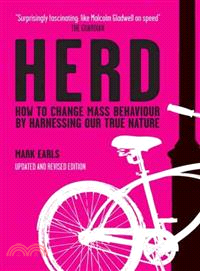Herd - How To Change Mass Behaviour By Harnessing Our True Nature
商品資訊
ISBN13:9780470744598
出版社:John Wiley & Sons Inc
作者:Earls
出版日:2009/07/17
裝訂/頁數:平裝/432頁
規格:20.3cm*12.7cm*2.5cm (高/寬/厚)
商品簡介
作者簡介
目次
相關商品
商品簡介
"...fascinating. Like Malcolm Gladwell on speed."
—THE GUARDIAN
"HERD is a rare thing: a book that transforms the reader's perception of how the world works".
—Matthew D'Ancona, THE SPECTATOR
"This book is a must. Once you have read it you will understand why Mark Earls is regarded as a marketing guru."
—Daniel Finkelstein, THE TIMES
This paperback version of Mark Earls' groundbreaking and award winning book comes updated with new stats and figures and provides two completely revised chapters that deal with the rise of social networking.
Since the Enlightenment there has been a very simple but widely held assumption that we are a species of thinking individuals and human behaviour is best understood by examining the psychology of individuals. It appears, however, that this insight is plain wrong. The evidence from a number of leading behavioural and neuroscientists suggests that our species is designed as a herd or group animal. Mark Earls applies this evidence to the traditional mechanisms of marketing and consumer behaviour, with a result that necessitates a complete rethink about these subjects.
HERD provides a host of unusual examples and anecdotes to open the mind of the business reader, from Peter Kay to Desmond Tutu, Apple to UK Sexual Health programmes, George Bush to Castle Lager, from autism to depression to the real explanation for the placebo effect in pharmaceutical testing.
—THE GUARDIAN
"HERD is a rare thing: a book that transforms the reader's perception of how the world works".
—Matthew D'Ancona, THE SPECTATOR
"This book is a must. Once you have read it you will understand why Mark Earls is regarded as a marketing guru."
—Daniel Finkelstein, THE TIMES
This paperback version of Mark Earls' groundbreaking and award winning book comes updated with new stats and figures and provides two completely revised chapters that deal with the rise of social networking.
Since the Enlightenment there has been a very simple but widely held assumption that we are a species of thinking individuals and human behaviour is best understood by examining the psychology of individuals. It appears, however, that this insight is plain wrong. The evidence from a number of leading behavioural and neuroscientists suggests that our species is designed as a herd or group animal. Mark Earls applies this evidence to the traditional mechanisms of marketing and consumer behaviour, with a result that necessitates a complete rethink about these subjects.
HERD provides a host of unusual examples and anecdotes to open the mind of the business reader, from Peter Kay to Desmond Tutu, Apple to UK Sexual Health programmes, George Bush to Castle Lager, from autism to depression to the real explanation for the placebo effect in pharmaceutical testing.
作者簡介
Mark Earls is one of the leading thinkers about brands, marketing and mass behaviour.
He has held senior positions in some of the largest and most influential communications companies in the world – his last job was as chair of Ogilvy’s Global Planning Council, prior to which he was Planning Director at the revolutionary St. Luke’s Communications in London.
His written work has regularly won awards from his peers and is considered by many to be amongst the most influential being written about consumer and mass behaviour today. His first book, Welcome to the Creative Age, was widely read and discussed and has been translated into several languages. HERD has received recognition and praise in a number of fields and Mark has travelled extensively to talk about HERD with audiences drawn from both the business and the public sector.
Mark lives in North London but would rather be watching cricket or fishing, ideally somewhere sunny.
He has held senior positions in some of the largest and most influential communications companies in the world – his last job was as chair of Ogilvy’s Global Planning Council, prior to which he was Planning Director at the revolutionary St. Luke’s Communications in London.
His written work has regularly won awards from his peers and is considered by many to be amongst the most influential being written about consumer and mass behaviour today. His first book, Welcome to the Creative Age, was widely read and discussed and has been translated into several languages. HERD has received recognition and praise in a number of fields and Mark has travelled extensively to talk about HERD with audiences drawn from both the business and the public sector.
Mark lives in North London but would rather be watching cricket or fishing, ideally somewhere sunny.
目次
Dedication.
About the Author.
Foreword by Russell Davies.
Notes on Paperback edition.
Introduction.
At the ‘cellotaph’.
Ghostbikes.
So how are we to explain this kind of thing?
Bigger boys made me do it.
A book about mass behaviour.
Mass behaviour is hard to change.
Bad theory, bad plan. Better theory? Better plan?
Old news?
I and the other.
Market research and me.
We’re all individuals – I’m not.
Understanding the how not just the what?
What the book will cover.
How to use this book.
Part One: A ‘We-Species’ with an illusion of ‘I’.
1: The Super-Social Ape.
Tea and kindness.
Advertising works.
Even more advertising works.
We want to be together.
Say what you see.
A we-species.
Are we stardust?
The successful ape.
Homo or Pan?
When I grow up.
Primates are social.
Why the naked ape?
Sexuality.
The infant ape.
So why naked then?
The brain of a social ape par excellence.
How others shape us.
How we make each other unhappy.
The social brain.
The sound of the crowd.
The empathetic ape.
Language and stroking.
The loneliness of autism.
Collaboration: the keys to the kingdom.
Self-interest and collaboration.
Game on.
Game over and over.
Collaboration across the nation?
Learning from each other?
How collaboration built the world.
Shirts – the work of many hands.
Summary of this chapter.
Questions to ponder.
Questions and issues for marketers.
2: The Illusion of ‘I’.
Pepper’s ghost.
What does Pepper’s ghost tell us?
I woke up this morning . . .
What it is – oh, I forgot.
Eternal sunshine and spotless minds.
False memories.
Monkey see.
Lazy minds.
Don’t think too hard.
Retelling the story.
The big when.
The illusion of consciousness.
Depression and the distorted self.
Treatments.
Summary of this chapter.
Issues arising.
Questions and implications for marketers.
3: ‘I’ vs. ‘Us’.
Yes we can.
Travelling for real.
Beware Greeks.
Ubuntu.
Peace and reconciliation.
Wo die Zitronen blühn.
Studying consumer tribal behaviour.
Beyond marketing.
Far from the madding crowds.
The politics of ‘I’.
The collective mind.
No such thing as society.
Is the rest of the world so wrong?
‘I’ ideology.
How social psychology got individualized.
‘I’ research.
Expert opinion.
Heroes and villains, and other individuals.
Unhappy feet?
The curious tale of curious George.
What this chapter has demonstrated.
Some questions.
Issues for marketers arising from this chapter.
Part Two: The Seven Principles of Herd Marketing.
4: Key Principle No. 1: Interaction.
At the market.
At the urinal.
In the lecture theatre.
Complexity vs. complicated.
Complexity as a way of seeing the world.
Interactive animals.
Interactive humans.
Back to the football
Learning from the Mexican wave.
At the office.
Meanwhile, somewhere in Aberdeen.
Summary so far.
Every day, every day, in every way . . .
Crime and punishment.
New York, New York.
The physics of crime.
More crime, less physics.
Crims, saints and fl oaters.
Fighting on the beaches (and in the suburbs).
The facts.
Analysis.
What to do about such riots.
Markets and interaction.
Behavioural markets.
The challenge for market research.
Issues arising.
Implications and questions for marketing and business.
5: Key Principle No. 2: Influence.
Saturday night’s all right.
Faces in the crowd.
1-2-3-4 . . .
Brainwashing.
Brainwashing and conformity.
Parallel lines.
Fear and needles.
Hands together, please.
The placebo effect.
What do you do to me?
Stupid boy.
Marky Mark is not Infl uential.
Why one-to-one is wrong.
Charidee, my friends.
Relation-canoes.
Relationships redux.
Channel tunnel vision.
From you to me to me and everyone I know.
Getting over yourself.
More influence.
The Milgram experiment.
Let the tapes roll.
How good people do bad things.
Born unequal?
Naturally infl uential?
Social infl uencers.
Connectedness.
Meet Lois.
Infl uence and infl uencers.
Researching influence.
Learning from Decision Watch.
The Infl uenced not the Infl uencer.
What this chapter has shown.
Some questions for marketing.
6: Key Principle No. 3: Us-Talk.
Don’t believe the hype.
Children of the revolution.
So why is the record industry so scared?
Scary Mary.
What can we learn from the Arctic Monkeys’ success?
Boom time for WoM Marketing.
What does Marketing (really) know about WoM?
WoM Fact 1. Word of mouth is seen by consumers to be more important than other infl uences on individual purchases.
WoM Fact 2. Word of mouth is seen to be getting more and more important over time.
WoM Fact 3. Word of mouth seems to operate in both B2B and B2C.
WoM Fact 4. Word of mouth is a global – and not just a North American – phenomenon.
Astroturfing.
I WoM Redux.
Grooming & feeling good.
Talk and grooming.
More grooming talk.
How bad science changed the mind of a nation.
Real impacts.
What can we learn from the MMR case?
The conversation has already started.
Us-talk again.
It’s not all (or even mostly) about you!
Paying for it.
Talk in the real world.
Talking about telly.
That one number again.
Don’t Matter What You Say: the One Number Still Matters.
What this chapter has shown.
What’s next?
Questions for marketing.
7: Key Principle No. 4: Just Believe.
Disappointed of Des Moines (or Dunstable)?
Meaning in a world of oversupply.
Three principles explained.
Goodnight Vienna.
I believe.
Cardigan Bay’s third biggest clothing company.
Outdoor threads.
Nice to have?
Think differently.
The journey (home).
Jamie’s dinners.
Being Naked.
Anomalous Thinking.
Back to the future.
Enron and everything after.
A challenge – does belief pay?
So what does the study show?
You are not alone.
Free and legal.
A is for . . .
Before we go.
1. Be who you are.
2. What do you believe in? Find it and live it!
3. Act like you mean it (and don’t act like you don’t . . .).
Summary: taking a stand.
Some questions arising for marketing.
8: Key Principle No. 5: (Re-)Light the Fire.
Keep the home fi res burning.
The fi re inside.
Easier to extinguish than light.
The misfits.
Relighting my fire.
The power of dreams.
Dream a little dream.
Vile bodies.
A familiar situation.
Girl talk.
The danger of missions.
You too can look like this.
More belief.
’T ain’t what you say.
The fi re inside – summary so far.
Where next?
How to work out what to do?
More behaviour thinking.
Show, don’t tell.
Interlude: Beyond Petroleum.
Belief in a cynical age.
Cynics and dogs.
Spotting cheaters.
Conclusions.
Questions for marketers.
9: Key Principle No. 6: Co-Creativity.
Unlikely popstars vol. 103.
Charidee, my friends.
Number one and everything after.
So what does the ‘Amarillo’ syndrome teach us?
Originality and creativity.
(Value) chain of fools?
Is this new news?
Hi-tech co-creativity.
Welcome to SIM City.
Rewriting history (together?).
Galileo, Newton and Einstein.
Another ‘pencil squeezer’?
Co-creativity – summary so far.
Meetings, bloody meetings.
Kick-off.
At the theatre.
Co-creative marketing attempts to change mass behaviour.
I saw this and I thought of you.
Using co-creativity to change internal audience mass behaviour.
The Hawthorne effect and after.
Co-creative innovation.
Two types of co-creative networks.
The Ocean’s 11 dream team.
Co-creativity and market research (1).
Co-creativity and market research (2).
Some ideas that co-creativity challenges.
Some questions for marketing.
10: Key Principle No. 7: Letting Go.
What a score!
The limits of my powers.
The loneliness of the touchline.
What Carwyn did and didn’t do.
The loneliness of the manager.
The company as machine.
Reducing the human element.
Children of the lesser god.
Another point of view.
Human remains.
Interaction businesses.
A different kind of job.
Back to the drawing board?
So what can you do?
More human physics.
Crisis, what crisis?
Let them all talk.
Talk with the talkers.
What do they talk of?
And fi nally . . .
As inside, so outside.
The end of management.
Some questions for marketing.
Part Three: Making Sense of the Herd.
11: Conclusions.
Life, the universe and giant aquatic reptiles.
Seeing things differently.
Conclusion 1: Our species is fi rst and foremost a social one.
Implication 1: Stop thinking and talking with words that conjure the ‘I’ perspective.
Conclusion 2: Individuals are unreliable (if not largely irrelevant) witnesses.
Implication 2: Don’t ask.
Conclusion 3: Interaction is everything; interaction is the ‘big how’.
Implication 3: Understand the how-mechanic and use it.
Conclusion 4: C2C, not B2C.
Implication 4: Get the system to work for you.
Conclusion 5: MVC vs. MIC?
Implication 5: Rethink targeting.
Conclusion 6: Communication is not about sending information.
Implication 6: Communication and action.
Conclusion 7: What people say is just the most visible infl uence.
Implication 7: Make peer-to-peer interaction the real goal of all marketing (and not just WoM).
Conclusion 8: Be more interesting.
Implication 8: Find your Purpose-Idea and live it.
Conclusion 9: Co-create.
Implication 9: Learn to be a great co-creator.
Conclusion 10: Letting go.
Implication 10: Rethink ‘management’.
Postscript to the Paperback edition.
And it’s goodnight from him . . .
Endnotes.
Index.
About the Author.
Foreword by Russell Davies.
Notes on Paperback edition.
Introduction.
At the ‘cellotaph’.
Ghostbikes.
So how are we to explain this kind of thing?
Bigger boys made me do it.
A book about mass behaviour.
Mass behaviour is hard to change.
Bad theory, bad plan. Better theory? Better plan?
Old news?
I and the other.
Market research and me.
We’re all individuals – I’m not.
Understanding the how not just the what?
What the book will cover.
How to use this book.
Part One: A ‘We-Species’ with an illusion of ‘I’.
1: The Super-Social Ape.
Tea and kindness.
Advertising works.
Even more advertising works.
We want to be together.
Say what you see.
A we-species.
Are we stardust?
The successful ape.
Homo or Pan?
When I grow up.
Primates are social.
Why the naked ape?
Sexuality.
The infant ape.
So why naked then?
The brain of a social ape par excellence.
How others shape us.
How we make each other unhappy.
The social brain.
The sound of the crowd.
The empathetic ape.
Language and stroking.
The loneliness of autism.
Collaboration: the keys to the kingdom.
Self-interest and collaboration.
Game on.
Game over and over.
Collaboration across the nation?
Learning from each other?
How collaboration built the world.
Shirts – the work of many hands.
Summary of this chapter.
Questions to ponder.
Questions and issues for marketers.
2: The Illusion of ‘I’.
Pepper’s ghost.
What does Pepper’s ghost tell us?
I woke up this morning . . .
What it is – oh, I forgot.
Eternal sunshine and spotless minds.
False memories.
Monkey see.
Lazy minds.
Don’t think too hard.
Retelling the story.
The big when.
The illusion of consciousness.
Depression and the distorted self.
Treatments.
Summary of this chapter.
Issues arising.
Questions and implications for marketers.
3: ‘I’ vs. ‘Us’.
Yes we can.
Travelling for real.
Beware Greeks.
Ubuntu.
Peace and reconciliation.
Wo die Zitronen blühn.
Studying consumer tribal behaviour.
Beyond marketing.
Far from the madding crowds.
The politics of ‘I’.
The collective mind.
No such thing as society.
Is the rest of the world so wrong?
‘I’ ideology.
How social psychology got individualized.
‘I’ research.
Expert opinion.
Heroes and villains, and other individuals.
Unhappy feet?
The curious tale of curious George.
What this chapter has demonstrated.
Some questions.
Issues for marketers arising from this chapter.
Part Two: The Seven Principles of Herd Marketing.
4: Key Principle No. 1: Interaction.
At the market.
At the urinal.
In the lecture theatre.
Complexity vs. complicated.
Complexity as a way of seeing the world.
Interactive animals.
Interactive humans.
Back to the football
Learning from the Mexican wave.
At the office.
Meanwhile, somewhere in Aberdeen.
Summary so far.
Every day, every day, in every way . . .
Crime and punishment.
New York, New York.
The physics of crime.
More crime, less physics.
Crims, saints and fl oaters.
Fighting on the beaches (and in the suburbs).
The facts.
Analysis.
What to do about such riots.
Markets and interaction.
Behavioural markets.
The challenge for market research.
Issues arising.
Implications and questions for marketing and business.
5: Key Principle No. 2: Influence.
Saturday night’s all right.
Faces in the crowd.
1-2-3-4 . . .
Brainwashing.
Brainwashing and conformity.
Parallel lines.
Fear and needles.
Hands together, please.
The placebo effect.
What do you do to me?
Stupid boy.
Marky Mark is not Infl uential.
Why one-to-one is wrong.
Charidee, my friends.
Relation-canoes.
Relationships redux.
Channel tunnel vision.
From you to me to me and everyone I know.
Getting over yourself.
More influence.
The Milgram experiment.
Let the tapes roll.
How good people do bad things.
Born unequal?
Naturally infl uential?
Social infl uencers.
Connectedness.
Meet Lois.
Infl uence and infl uencers.
Researching influence.
Learning from Decision Watch.
The Infl uenced not the Infl uencer.
What this chapter has shown.
Some questions for marketing.
6: Key Principle No. 3: Us-Talk.
Don’t believe the hype.
Children of the revolution.
So why is the record industry so scared?
Scary Mary.
What can we learn from the Arctic Monkeys’ success?
Boom time for WoM Marketing.
What does Marketing (really) know about WoM?
WoM Fact 1. Word of mouth is seen by consumers to be more important than other infl uences on individual purchases.
WoM Fact 2. Word of mouth is seen to be getting more and more important over time.
WoM Fact 3. Word of mouth seems to operate in both B2B and B2C.
WoM Fact 4. Word of mouth is a global – and not just a North American – phenomenon.
Astroturfing.
I WoM Redux.
Grooming & feeling good.
Talk and grooming.
More grooming talk.
How bad science changed the mind of a nation.
Real impacts.
What can we learn from the MMR case?
The conversation has already started.
Us-talk again.
It’s not all (or even mostly) about you!
Paying for it.
Talk in the real world.
Talking about telly.
That one number again.
Don’t Matter What You Say: the One Number Still Matters.
What this chapter has shown.
What’s next?
Questions for marketing.
7: Key Principle No. 4: Just Believe.
Disappointed of Des Moines (or Dunstable)?
Meaning in a world of oversupply.
Three principles explained.
Goodnight Vienna.
I believe.
Cardigan Bay’s third biggest clothing company.
Outdoor threads.
Nice to have?
Think differently.
The journey (home).
Jamie’s dinners.
Being Naked.
Anomalous Thinking.
Back to the future.
Enron and everything after.
A challenge – does belief pay?
So what does the study show?
You are not alone.
Free and legal.
A is for . . .
Before we go.
1. Be who you are.
2. What do you believe in? Find it and live it!
3. Act like you mean it (and don’t act like you don’t . . .).
Summary: taking a stand.
Some questions arising for marketing.
8: Key Principle No. 5: (Re-)Light the Fire.
Keep the home fi res burning.
The fi re inside.
Easier to extinguish than light.
The misfits.
Relighting my fire.
The power of dreams.
Dream a little dream.
Vile bodies.
A familiar situation.
Girl talk.
The danger of missions.
You too can look like this.
More belief.
’T ain’t what you say.
The fi re inside – summary so far.
Where next?
How to work out what to do?
More behaviour thinking.
Show, don’t tell.
Interlude: Beyond Petroleum.
Belief in a cynical age.
Cynics and dogs.
Spotting cheaters.
Conclusions.
Questions for marketers.
9: Key Principle No. 6: Co-Creativity.
Unlikely popstars vol. 103.
Charidee, my friends.
Number one and everything after.
So what does the ‘Amarillo’ syndrome teach us?
Originality and creativity.
(Value) chain of fools?
Is this new news?
Hi-tech co-creativity.
Welcome to SIM City.
Rewriting history (together?).
Galileo, Newton and Einstein.
Another ‘pencil squeezer’?
Co-creativity – summary so far.
Meetings, bloody meetings.
Kick-off.
At the theatre.
Co-creative marketing attempts to change mass behaviour.
I saw this and I thought of you.
Using co-creativity to change internal audience mass behaviour.
The Hawthorne effect and after.
Co-creative innovation.
Two types of co-creative networks.
The Ocean’s 11 dream team.
Co-creativity and market research (1).
Co-creativity and market research (2).
Some ideas that co-creativity challenges.
Some questions for marketing.
10: Key Principle No. 7: Letting Go.
What a score!
The limits of my powers.
The loneliness of the touchline.
What Carwyn did and didn’t do.
The loneliness of the manager.
The company as machine.
Reducing the human element.
Children of the lesser god.
Another point of view.
Human remains.
Interaction businesses.
A different kind of job.
Back to the drawing board?
So what can you do?
More human physics.
Crisis, what crisis?
Let them all talk.
Talk with the talkers.
What do they talk of?
And fi nally . . .
As inside, so outside.
The end of management.
Some questions for marketing.
Part Three: Making Sense of the Herd.
11: Conclusions.
Life, the universe and giant aquatic reptiles.
Seeing things differently.
Conclusion 1: Our species is fi rst and foremost a social one.
Implication 1: Stop thinking and talking with words that conjure the ‘I’ perspective.
Conclusion 2: Individuals are unreliable (if not largely irrelevant) witnesses.
Implication 2: Don’t ask.
Conclusion 3: Interaction is everything; interaction is the ‘big how’.
Implication 3: Understand the how-mechanic and use it.
Conclusion 4: C2C, not B2C.
Implication 4: Get the system to work for you.
Conclusion 5: MVC vs. MIC?
Implication 5: Rethink targeting.
Conclusion 6: Communication is not about sending information.
Implication 6: Communication and action.
Conclusion 7: What people say is just the most visible infl uence.
Implication 7: Make peer-to-peer interaction the real goal of all marketing (and not just WoM).
Conclusion 8: Be more interesting.
Implication 8: Find your Purpose-Idea and live it.
Conclusion 9: Co-create.
Implication 9: Learn to be a great co-creator.
Conclusion 10: Letting go.
Implication 10: Rethink ‘management’.
Postscript to the Paperback edition.
And it’s goodnight from him . . .
Endnotes.
Index.
主題書展
更多
主題書展
更多書展今日66折
您曾經瀏覽過的商品
購物須知
外文書商品之書封,為出版社提供之樣本。實際出貨商品,以出版社所提供之現有版本為主。部份書籍,因出版社供應狀況特殊,匯率將依實際狀況做調整。
無庫存之商品,在您完成訂單程序之後,將以空運的方式為你下單調貨。為了縮短等待的時間,建議您將外文書與其他商品分開下單,以獲得最快的取貨速度,平均調貨時間為1~2個月。
為了保護您的權益,「三民網路書店」提供會員七日商品鑑賞期(收到商品為起始日)。
若要辦理退貨,請在商品鑑賞期內寄回,且商品必須是全新狀態與完整包裝(商品、附件、發票、隨貨贈品等)否則恕不接受退貨。
























